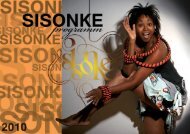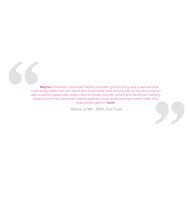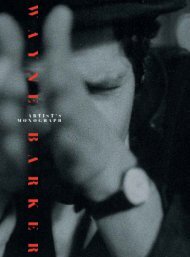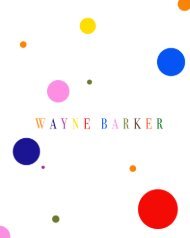WAYNE BARKER Beadworks 2011-2013
Presentation of beadworks (2011-2013) by the South African artist Wayne Barker
Presentation of beadworks (2011-2013) by the South African artist Wayne Barker
You also want an ePaper? Increase the reach of your titles
YUMPU automatically turns print PDFs into web optimized ePapers that Google loves.
<strong>WAYNE</strong> <strong>BARKER</strong><br />
<strong>2011</strong>-<strong>2013</strong> BEAD WORKS
Installation view Circa Gallery, Standard Bank <strong>2011</strong> & 2012
Sherlock Holmes, Sigmund Freud, and the Italian art-historian Giovanni Morelli<br />
may not at first appear to have anything in common with each other, let alone with<br />
Wayne Barker, but – as Carlo Ginzburg has argued in an influential essay – these three<br />
characters each embody a version of a particular modern approach both to problem<br />
solving and to the re-creation and discovery of the past. Holmes, Freud and Morelli<br />
all find clues to events in the past – whether crimes, forgotten events, or the identity<br />
of an original artist – in scattered small details: a footprint, an inexplicable dream,<br />
or the shape of an angel’s ear. These apparently trivial details yield rich rewards when closely<br />
studied.<br />
Wayne Barker should be associated with this trio and this tradition as, like them,<br />
he is part detective, part psychologist and part art historian. These threads come together<br />
successfully and naturally in his latest series of bead “paintings”. At first glance,<br />
the works are glittery, dazzling and seductive but it soon become clear that there is a rich<br />
vein of social comment buried beneath the bright surface. If we take Barker’s personal<br />
iconology into account we can recognise that these works represent a natural progression<br />
from his earliest work as a rebel bohemian attacking an establishment. His distinctive<br />
and unmistakable stylistic language has remained constant in the decades since his start.<br />
Text from «Super Boring» catalogue.<br />
Carol Brown, 2012<br />
Curator at Durban Art Museum, South Africa 2008<br />
International curator for Southern Africa
MY JOZIE DETAIL
MY JOZIE DETAIL
CHURCH LADY 200 x 200 cm
LAND & DESIRE 200 x 200 cm
GOLDEN CHURCH LADY 200 x 200 cm
LAND FOR SALE 200 x 200 cm
MADONNA BLUES 200 x 200 cm
JOBURG JAZZ 200 x 200 cm
CITY OF GOLD 200 x 200 cm
IT’S IN YOUR HEAD 200 x 200 cm
LADY GAGA 200 x 200 cm
CURRENT EVENTS //<br />
// ART FAIRS <strong>2013</strong> //<br />
London Art 13<br />
Dubai Art Fair<br />
Sydney Art Fair<br />
Johannesburg Art Fair<br />
// GROUP SHOWS <strong>2013</strong> //<br />
June <strong>2013</strong> : ”My Joburg”, Fondation Maison Rouge.<br />
Several local group shows in South Africa.<br />
// PUBLICATIONS //<br />
1.Featured in“Earth Matters: Land as Material and Metaphor in the Arts of Africa»,<br />
Smithonian Museum, <strong>2013</strong>.<br />
2. Featured in «Art at the end of apartheid» by John Peffer, University of Minnesota Press.<br />
3. «Art in South Africa» by Sue Williamson an Ashraf Jamal.<br />
4. ’Super Boring’ catalogue, Standard Bank retrospective.<br />
5. Artist’s Monograph, Wayne Barker.
PRESS //<br />
City Press, september 2012<br />
Two creative luminaries on parallel life paths<br />
found their work speaking in a singular voice<br />
at Circa on Jellicoe last week.<br />
The spectacular bad boy of South African art,<br />
painter Wayne Barker; and the sagacious jazz<br />
pianist, Abdullah Ibrahim, became the subject<br />
of a unique artistic conversation as their work<br />
serendipitously found a simultaneous audience<br />
at the Joburg gallery.<br />
The conversation involved Barker’s current<br />
exhibition of paintings and glass-bead panels<br />
titled Love Land and the music of the elder<br />
jazzman.<br />
Ibrahim gave a rare series of solo piano recitals<br />
at the venue. He followed these up with<br />
another series at the Everard Read Gallery in<br />
Cape Town.<br />
Under the sedate aura of Circa’s honey-coloured<br />
lights, the pianist soared into sonic vistas<br />
as the painter’s work attempted<br />
a visual equivalent.<br />
The fine artworks displayed in the main<br />
gallery hall also include a few works from the<br />
Legends series.<br />
Some of these formed part of Barker’s midcareer<br />
retrospective show, titled Super Boring,<br />
but were never shown.<br />
They are oil-on-canvas paintings dedicated to<br />
giants like Hugh Masekela, Nelson Mandela<br />
and, of course, Ibrahim himself.<br />
The painting (pictured bottom right) created in<br />
ode of the pianist is titled VICTORY. Its motif<br />
comprises a portrait of Ibrahim with his eyes<br />
closed and hands clasped, as if in prayer.<br />
The sage’s likeness is painted as an imposition<br />
on a Pierneef painting of an early urbanscape<br />
of the Cape of Good Hope.<br />
It is in line with Barker’s long-standing project<br />
of revisiting Pierneef’s landscapes.<br />
So Ibrahim’s meditative face is deployed to<br />
disrupt or intervene in Pierneef and his Afrikaner-nationalist<br />
unpeopled vision of<br />
South Africa.<br />
By insisting on Ibrahim’s inclusion in an Afrikaner<br />
nationalist’s representation of the Cape,<br />
Barker seeks to remind his forebear that the<br />
land and its people are one and that’s a beautiful<br />
thing.<br />
The rebelling younger painter then paints an<br />
olive branch along with the words “victory”<br />
and “play”.<br />
It’s another serendipitous gem in this interdisciplinary<br />
jam session, almost as if the painter<br />
knew that the victorious completion of the<br />
work will come when Ibrahim plays in the<br />
work’s presence.<br />
Circa’s cavernous structure, with more than<br />
200 art lovers congregated around the jazzman,<br />
acquired a ceremonial solemnity.<br />
This even as the pianist’s exacting appeal to<br />
decorum apparently contrasted the painterly<br />
recalcitrance of parts of Barker’s project.<br />
However, the works seemed to have found<br />
each other in the quintessential spirit of jazz.<br />
The marked ebb and flow of improvisation<br />
and premeditation seemed to be a unifying<br />
factor: like an inter-textual dialogue with every<br />
gracious melodic phrase on the piano finding<br />
a fitting answer in each whimsical brush<br />
stroke on Barker’s canvases.<br />
Barker relies on the whole history and tradition<br />
of painting along with the problematic legacy<br />
of dodgy creatives like Pierneef to ballast his<br />
blast of beauty.<br />
Ibrahim, too, ascended the plinth to sit at the<br />
baby grand piano with charts of composed<br />
music.<br />
So, as he issued immaculate clusters of<br />
improvised colours, there was an established<br />
sureness of hit songs like Ishmael, Blues For<br />
A Hip King and Tintinyana to provide a steady<br />
foundation. » Barker’s Love Land is on at<br />
Circa on Jellicoe in Rosebank, Joburg, until<br />
October 6








